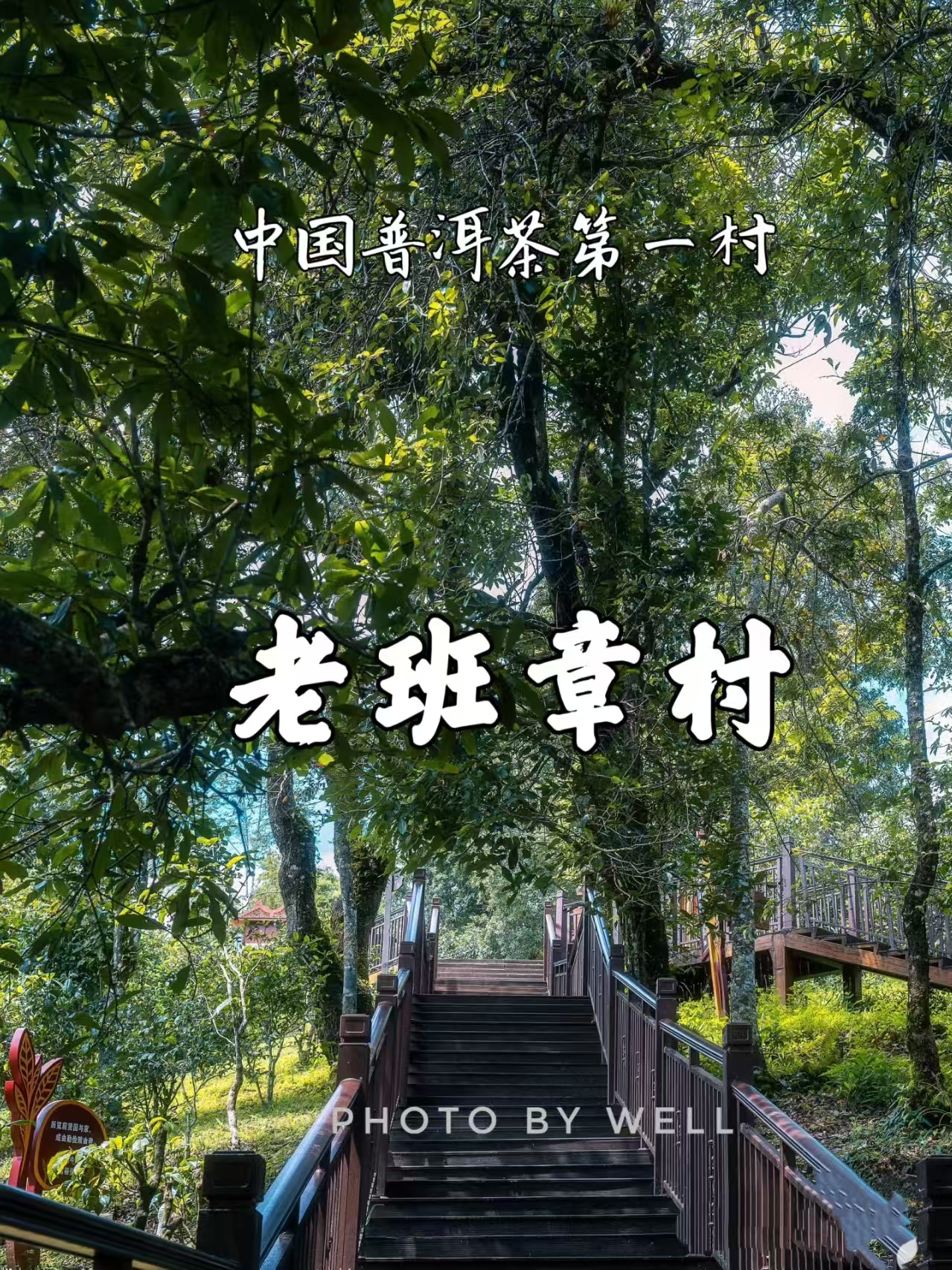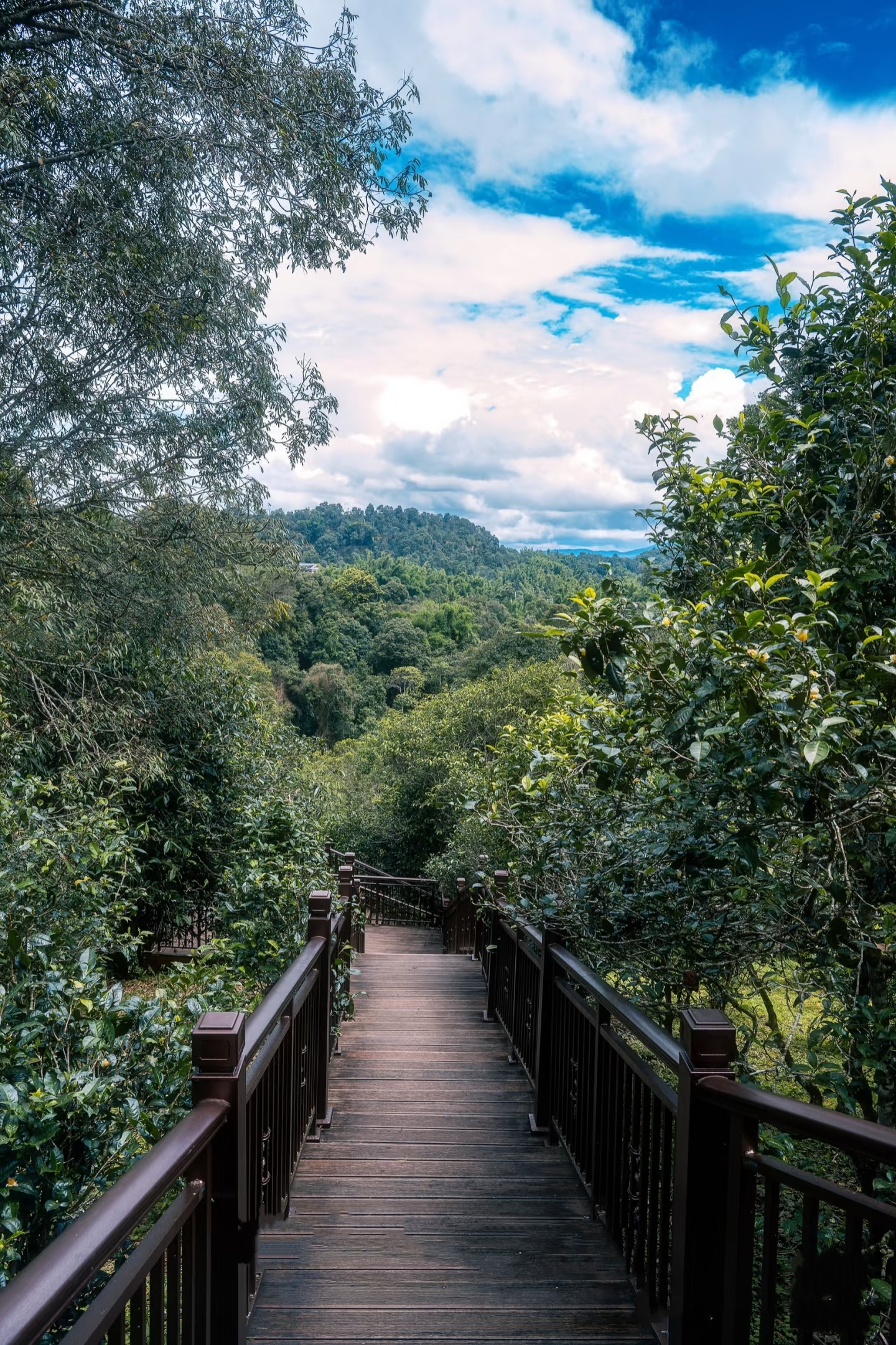In the world of Pu'er tea, Laobanzhang is an unavoidable legend. This ancient village located in Bulang Mountain, Menghai County, Xishuangbanna, Yunnan, writes the "King's Law" in the Pu'er tea world with its 4,700 mu ancient tea garden and the scarcity of only 50 tons per year. In 2025, although the price of Laobanzhang ancient tree tea raw materials has dropped from 25,000 yuan/kg last year to 15,600 yuan/kg, it still sits firmly at the top of the Pu'er tea price pyramid. This article will decode the ultimate charm of Laobanzhang from five dimensions: geographical code, craft secrets, taste philosophy, market game, and collection guide, and exclusively reveal the six major trends in the Pu'er tea market in 2025.

老班章地处北纬 21°,海拔 1700-1900 米,年均气温 18.7℃,年降水量 1341-1540 毫米。这里的红壤与黄壤富含矿物质,透气性极佳,为茶树提供了理想的生长环境。古茶园与原始森林混生,形成独特的 “茶树 - 乔木 - 灌木” 垂直生态系统,其中寄生植物螃蟹脚(石斛)的存在,进一步印证了生态多样性。
- Dry season (November-April): The temperature difference between day and night reaches 15℃, which promotes the accumulation of tea polyphenols and amino acids. A study by Yunnan Agricultural University in 2025 showed that the tea polyphenol content of Laobanzhang spring tea reached 38%, which is 1.5 times that of ordinary Pu'er tea.
- Rainy season (May-October): The average daily coverage of clouds and fog is 8 hours, and diffuse light accelerates the conversion of chlorophyll, forming the iconic "honey fragrance orchid rhyme" of Laobanzhang.
Laobanzhang was built in 1476 and now has more than 2,000 thousand-year-old tea trees. According to data from the Menghai County Agricultural Bureau in 2025, 35% of the trees are over 300 years old. The roots of these tea trees are up to 3 meters deep and can absorb trace elements from deep soil.

- Time window: The first spring picking period is from March 20 to April 10 every year, which lasts only 20 days. Tea farmers need to complete picking before 10 am, when the water content of fresh leaves is 80% and the enzyme activity is optimal.
- Picking standards: Strictly follow the "one bud and two leaves", and the bud length is controlled at 3-4 cm. In 2025, the new product of Bajiaoting, Laobanzhang, adopts the "screening and grading" process to divide the buds and leaves into three grades according to length to ensure the consistency of the taste of the finished tea.
- Traditional pan frying: Use a cast iron pan with a diameter of 1.2 meters, a pan temperature of 220℃, and a stir-frying time of 6-8 minutes. In 2025, Menghai Tea Factory introduced infrared temperature measurement technology, with an error control of ±2℃.
- Modern innovation: Some tea companies try "segmented killing", with high temperature (240℃) for the first 3 minutes to inactivate enzyme activity, and low temperature (180℃) for the last 5 minutes to retain aroma substances.
- Dry warehouse storage: humidity 60-70%, temperature 20-25℃. In 2025, the "Yuncha Warehouse" intelligent system can remotely control temperature and humidity, shortening the aging cycle by 30%.
- Microbial community: The Yunnan Institute of Microbiology showed that during the fermentation of Laobanzhang ripe tea, dominant bacteria such as Aspergillus niger, yeast, and lactic acid bacteria work together to produce functional ingredients such as lovastatin.
- Sensory experience: The soup is bright yellow-green, bitter and lightly astringent, the bitterness is concentrated on the tongue, and the astringency is evenly distributed. The comparative test of Iceland Laozhai Ancient Tree Tea in 2025 showed that the bitterness of Laobanzhang is 2.3 times that of Iceland, and the sweetness is 30% faster.
- Chemical analysis: The content of tea polyphenols is 35%, caffeine is 4.2%, and the total amount of catechins is 28%, which constitutes the material basis of the "dominant" taste.
- Transformation code: Tea polyphenols are oxidized to thearubigins, the content increases to 12%, and the soup color turns golden yellow. A comparison of Yiwu Mahei raw tea in 2015 shows that the content of aged aromatic substances (such as terpenes) in Laobanzhang is 40% higher.
- Drinking scene: Suitable for business reception, the mellowness and depth of the tea soup can show the taste of the host.
- Ultimate form: Thea brown pigment content exceeds 15%, the soup is as red and thick as red wine, and the taste is "as dense as silk". In the 2025 Beijing Poly Spring Auction, the 1988 "88 Green Cake" (Lao Banzhang raw material) was sold at 1.28 million yuan per piece, with an annualized yield of 15%.
- Cultural value: The Palace Museum's co-branded tea "Banzhang Gongcha" uses the Qing Dynasty tribute tea craftsmanship, with a premium rate of 200%.

- Market conditions in 2025: Raw materials of ancient tea trees are 10,000-15,600 yuan/kg, down 37.6% from 2024, but still 50 times that of ordinary Pu'er tea.
- Reasons for the decline: domestic economic downturn, inventory backlog, and changes in young consumers' preferences (such as rising demand for convenient packaged cooked tea).
- Auction record: In the 2025 Shanghai Guardian Spring Auction, the 2003 "SARS Banzhang" was sold for 8 million yuan per piece, setting a new record for the price of a single cake.
- Investment logic: Old Banzhang accounts for 35% of the Pu'er tea collection market share, and its scarcity (annual production of 50 tons) and cultural premium (the perception that "Banzhang is king") constitute its core value.
- High-end market: The annual sales volume of pure tea from ancient trees (such as the new product Laobanzhang from Bajiaoting) increased by 15%, and the collectors aged 30-40 accounted for 45%.
- Mass market: Blended tea (such as Dayi "7572") accounted for 65% of the market share, with a price range of 100-300 yuan per cake.
- Tea leaves: Tea leaves from ancient trees have thick tea leaves, with visible buds and short interleaf spacing (1-2 cm). Tea leaves from terraced areas have thin tea leaves and long interleaf spacing (3-4 cm).
- Horseshoe foot: The "horse hoof" left on the petiole is a characteristic of tea leaves from ancient trees, with a diameter of ≥5 mm.
- New tea: honey aroma with orchid aroma, long-lasting cold cup aroma (more than 12 hours).
- Old tea: aged aroma, ginseng aroma and jujube aroma, no pungent musty smell.
- Thickness: The tea soup has a "gelatinous texture" when it enters the mouth, and the hanging time in the cup is ≥30 seconds.
- Aftertaste: The speed of bitterness turning into sweetness is ≤5 seconds, and the duration of aftertaste is ≥3 minutes.
- Activity: The bottom of the old tree tea leaves is very elastic and rebounds quickly after being pressed by fingers. The bottom of the terrace tea leaves is soft and the veins are unclear.
- Color: The bottom of new tea leaves is yellow-green, and the bottom of old tea leaves is reddish-brown, without burnt spots.
- Organic certification: ECOCERT certification is the EU market access threshold, and Rainforest Alliance certification ensures sustainable planting.
- Blockchain traceability: China Tea "Butterfly Brand" Pu'er tea uses blockchain technology, and you can scan the code to check the origin of the raw materials and fermentation batches.
- Brewing resistance: Ancient tree tea can be brewed for more than 15 times, and it still has a sweet taste after the 10th brew.
- Steeping test: Steep for 5 minutes. If the tea soup is not sour or astringent, it is well aged. If it is sour, it is a fermentation failure.
- New technology for cooked tea: "Low temperature and long fermentation" (40℃/60 days) improves the sweetness of tea soup, and "probiotic inoculation" technology reduces the pile smell.
- Raw tea storage: Intelligent storage systems (such as "cloud warehouses") can achieve remote control of temperature and humidity, shortening the aging cycle by 30%.
- Health labels: "Lipid-lowering cooked tea" and "antioxidant raw tea" have become hot-selling products in e-commerce, and the growth rate of functional products exceeds 40%.
- Cultural empowerment: The premium rate of the Palace Museum co-branded tea and intangible cultural heritage tea has reached 200%, and tea culture experience stores (such as "Dayi Tea Court") have become traffic entrances.
- Environmentally friendly materials: The "bamboo fiber tea warehouse" that will be popular in 2025 is biodegradable and more breathable than traditional cartons, reducing costs by 20%.
- Shared warehousing: Tea Friends Network has launched the "cloud warehouse sharing" model, where users can rent professional storage space online and charge by the day.
The charm of Laobanzhang lies not only in the uniqueness of its geographical environment and the rigor of its craftsmanship, but also in the cultural depth it carries. When the "88 Green Cake" repeatedly set sky-high prices at auctions in 1988, and when the price of raw materials of ancient tree tea remains strong in 2025, what we see is not only the economic value of tea, but also the awe and cherishment of human beings for the gifts of nature. In this era of rapid iteration, Laobanzhang interprets the "compound interest of time" and "the eternity of craftsmanship" with the story of a leaf.
- 中国茶叶流通协会. 《2025 年中国普洱茶产业发展报告》. 2025.
- 云南农业大学. 《普洱茶陈化过程中茶多酚转化机制研究》. 2025.
- 正能量河流 0. 《云南 2025 年春茶预报价发布老班章 15600 元 / 公斤,冰岛 95000 元 / 公斤》. 2025.
- 19 楼. 《探究老班章茶区:揭秘普洱茶中的王者之谜与周边产区比较》. 2025.
- 茶友网. 《人人皆知的十个普洱茶代表性山头》. 2023.
- 陈年普洱茶. 《老班章的收藏价值和市场前景分析:是否值得投资?》. 2024.
- 马可波罗. 《老班章值得收藏吗?收藏价值和价格如何?_普洱茶_综合资讯》. 2024.
- 百企资讯. 《老班章拍卖记录及最贵价格_普洱茶》. 2024.
- 选调生网. 《探秘老班章普洱茶拍卖市场:历年价格走势与最新成交记录分析》. 2025.
- 19 楼. 《老班章制作工艺:老班章制作过程与工艺详解》. 2025.
- 马可波罗. 《老班章的工艺:制作步骤、效果及简介评价》. 2025.
- 抖音百科. 《老班章 (云南西双版纳州勐海县下辖村)_百科》. 2025.
- 马可波罗网. 《老班章地理环境与位置、气候、地名来历_普洱茶_综合资讯》. 2024.
- 松花江网. 《老班章产区最老古树茶全方位解读》. 2025.
- 勐海县人民政府. 《勐海县农业农村局关于勐海县老班章乡村振兴示范园建设项目专项审计调查反馈问题 整改情况》. 2025.
- 云南微生物研究所. 《渥堆发酵菌群多样性研究》. 2024.
- 云南云茶仓项目. 《2025 年智能仓储技术应用报告》. 2025.







